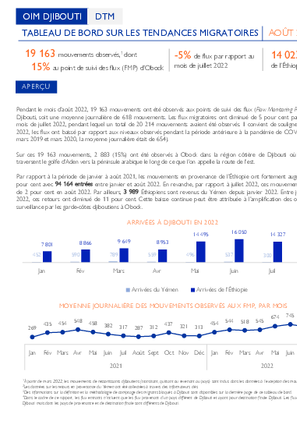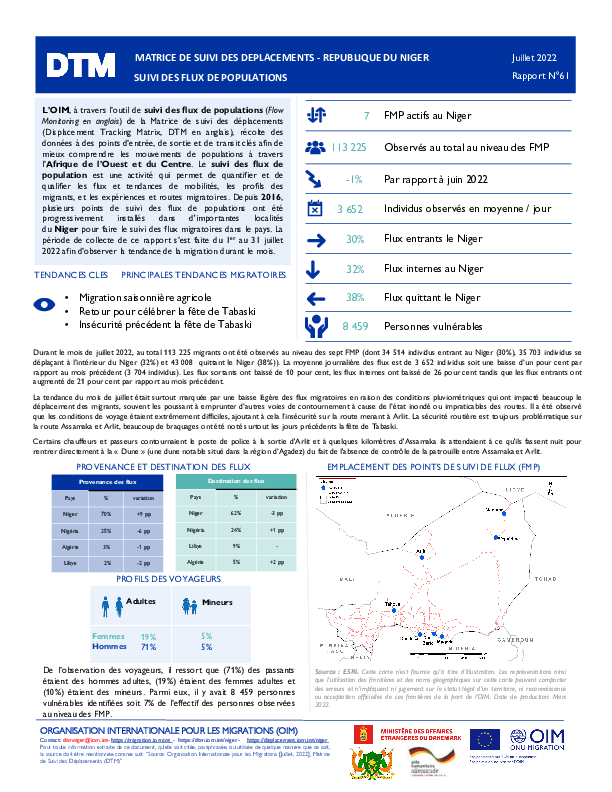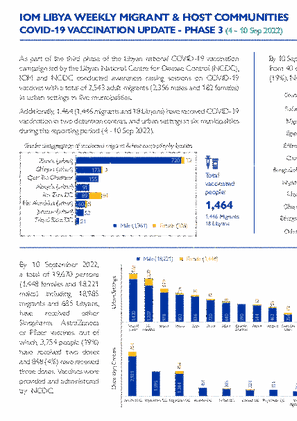-
Countries
-
Data and Analysis
-
Special Focus
-
Crisis Responses
The Central African Republic, which has experienced continuous volatility for the past two decades, has been riddled by a crisis which ignited in 2012 with a violent takeover of power and has developed into a complex protracted state of permanent insecurity and fragility which has spilled over into neighbouring countries. The crisis has led to the death of an estimated 506 people in 2022 (as of 30 April) and triggered significant displacement of populations in the seven affected countries. The crisis is characterized by power struggles amongst elites, the absence of state institutions and public investment, religious and ethnic tensions and disputes for the control of key resources.
As of 22 August 2022, 3,348,371 individuals were displaced, including 647,883 Internally Displaced Persons (19% of the displaced population), 1,588,289 Returnees (former IDPs) (47%), 377,297 Returnees from abroad (11%) and 734,902 Refugees in neighbouring countries (22%). In the Central African Republic, the largest displaced population consists of Former IDP Returnees (62%), while IDPs represent 24 per cent of the displaced population present in the country and Returnees from abroad represent 14 per cent of in-country displaced people. Refugees from the Central African Republic are primarily hosted by Cameroon (347,575 individuals, or 47% of refugees), the Democratic Republic of the Congo (206,967 individuals, or 28% of refugees) and Chad (124,488 individuals, or 17% of refugees).
La République centrafricaine (RCA) a été témoin de volatilité incessante depuis deux décennies. La dernière crise atteignant le pays a débuté en 2012, suite à une prise du pouvoir accouchée dans la violence, et a depuis évolué en un état d’insécurité et de fragilité permanentes, découlant d’une crise complexe de long-terme qui s’est étendue dans les pays voisins. La crise a conduit au décès de 506 personnes en 2022 (au 30 avril) et a déclenché des déplacements massifs de populations dans les sept pays touches par la crise. Cette dernière est caractérisée par des rivalités pour le pouvoir parmi les élites du pays, l’absence d’institutions étatiques et d’investissement d’argent public, des tensions inter-ethniques et inter-religieuses et la lutte pour le contrôle de ressources.
Au 22 août 2022, 3 348 371 individus étaient déplacés, dont 647 883 Personnes déplacées internes (19% de la population déplacées), 1 588 289 Retournées (anciennes PDI) (47%), 377 287 Retournés de l’étranger (11%) et 734 902 Réfugiés dans les pays limitrophes (22%). En RCA, les Retournés anciennes PDI représentent la plus grande population affectée (62%), tandis que les PDI représentent 24 pour cent de la population atteinte dans le pays et les Retournés de l’étranger 15 pour cent de la population déplacée présente dans le pays. Les réfugiés centrafricains résident principalement au Cameroun (347 575 individus, soit 47% des réfugiés), la République démocratique du Congo (206 967 individus, soit 28% des réfugiés) et au Tchad (124 488 individus, soit 17% des réfugiés).

Contact
DTM Djibouti, DTMDjibouti@iom.int
Language
French
Location
Djibouti
Period Covered
Aug 01 2022
Aug 31 2022
Activity
- Flow Monitoring
Pendant le mois d’août 2022, 19 163 mouvements ont été observés aux points de suivi des flux (Flow Monitoring Points, FMP) à
Djibouti, soit une moyenne journalière de 618 mouvements. Les flux migratoires ont diminué de 5 pour cent par rapport au
mois de juillet 2022, pendant lequel un total de 20 214 mouvements avaient été observés. Il convient de souligner qu’en août
2022, les flux ont baissé par rapport aux niveaux observés pendant la période antérieure à la pandémie de COVID-19 (entre
mars 2019 et mars 2020, la moyenne journalière était de 654).
Sur ces 19 163 mouvements, 2 883 (15%) ont été observés à Obock dans la région côtière de Djibouti où les migrants
traversent le golfe d'Aden vers la péninsule arabique le long de ce que l'on appelle la route de l'est.
Par rapport à la période de janvier à août 2021, les mouvements en provenance de l’Éthiopie ont fortement augmenté de 69
pour cent avec 94 164 entrées entre janvier et août 2022. En revanche, par rapport à juillet 2022, ces mouvements ont baissé
de 2 pour cent en août 2022. Par ailleurs, 3 989 Éthiopiens sont revenus du Yémen depuis janvier 2022. Entre juillet et août
2022, ces retours ont diminué de 11 pour cent. Cette baisse continue peut être attribuée à l’amplification des opérations de
surveillance par les garde-côtes djiboutiens à Obock.

Contact
DTM Djibouti, DTMDjibouti@iom.int
Language
English
Location
Djibouti
Period Covered
Aug 01 2022
Aug 31 2022
Activity
- Flow Monitoring
In August 2022, 19,163 movements were observed at the Flow Monitoring Points (FMPs) in Djibouti, representing a daily
average of 618 movements. Migration flows decreased by 5 per cent compared to July 2022, during which a total of 20,214
movements had been registered. It is worth highlighting that in August 2022 migration flows have dropped below pre-COVID-
19 levels (between March 2019 and March 2020, the daily average was 654).
Of these 19,163 movements, 2,883 (15%) were observed in Obock. This coastal region of Djibouti is the main gateway for
migrants going to and returning from the Arabian Peninsula. Migrants regroup at congregation points in the Obock region where
they then cross the Gulf of Aden on boats along what is known as the Eastern route.
Compared to the period of January to August 2021, movements from Ethiopia have increased sharply by 69 per cent with
94,164 entries between January and August 2022. However, compared to July 2022, these movements decreased by 2 per cent in August 2022. In addition, 3,989 Ethiopians have returned from Yemen since January 2022. Between July 2022 and August 2022, these returns decreased by 11 per cent. This continuous decrease may be attributed to the amplified surveillance operations by the Djiboutian coast guards in Obock.

Contact
DTM DRC, iomdrcdtm@iom.int
Language
French
Location
Democratic Republic of the Congo
Period Covered
Aug 18 2022
Aug 26 2022
Activity
- Mobility Tracking
- Baseline Assessment
Ce rapport présente les résultats de l'enquête sur les intentions de relocalisation et de transfert menée du 18 au 26 août 2022. Cette enquête fournit des informations sur les profils, les caractéristiques du déplacement et les intentions en termes de solutions durables ou de relocalisation, pour la population déplacée de EP Matumaini, de EP Remera, de EP Rugabo, du stade de Rugabo et du territoire de Rutshuru, province du Nord-Kivu.

Contact
DTM Sudan; dtmsudan@iom.int
Language
English
Location
Sudan
Snapshot Date
Sep 07 2022
Activity
- Mobility Tracking
- Event Tracking
As a subcomponent of the Mobility Tracking methodology (Round Four), the Emergency Event Tracking (EET) tool is deployed to track sudden displacement, provide more frequent updates on the scale of displacement, and quantify the affected population when needed.

Contact
DTM Niger, DTMNiger@iom.int
Language
French
Location
Niger
Period Covered
Jul 01 2022
Jul 31 2022
Activity
- Flow Monitoring
Le suivi des flux de population est une activité qui permet de quantifier et de qualifier les flux et tendances de mobilités, les profils des migrants, et les expériences et routes migratoires. Ce rapport présente les données recueillies à travers l'enregistrement des flux de populations entre le 1er et le 31 juillet 2022 aux sept points de suivi des flux (FMP) du Niger, reflétant les tendances migratoires observées dans le pays au cours du mois.

Contact
DTM Libya, DTMLibya@iom.int
Language
English
Location
Libya
Period Covered
Sep 04 2022
Sep 10 2022
Activity
- Other
As part of the third phase of the Libyan national COVID-19 vaccination campaign led by the Libyan National Centre for Disease Control (NCDC), IOM and NCDC conducted awareness raising sessions on COVID-19 vaccines with a total of 2,543 adult migrants (2,356 males and 182 females) in urban settings in five municipalities. Additionally, 1,464 (1,446 migrants and 18 Libyans) have received COVID-19 vaccination in two detention centres, and urban settings in six municipalities during the reporting period (4 - 10 Sep 2022).

Contact
DTM Europe, DTMMediterranean@iom.int
Language
English
Location
Republic of Moldova
Period Covered
Jul 20 2022
Sep 04 2022
Activity
- Survey
- Return Intention
Since 24 February 2022, people have been fleeing from Ukraine to the neighbouring countries as a result of the war in Ukraine. As of 04 September 2022, 597,984 refugees from Ukraine and Third Country Nationals (TCNs) were registered at border crossing points (BCPs) while entering from Ukraine into the Republic of Moldova. At the same time, movements of persons crossing back to Ukraine have also been reported. According to national authorities, 147,577 Ukrainian nationals and TCNs, who have entered into the Republic of Moldova after 24 February 2022, have since exited back to Ukraine (Source: General Inspectorate for Border Police).
Since April 2022, International Organization for Migration (IOM) has conducted displacement and intention surveys with adults (18 years and above) crossing back to Ukraine, through CBS Axa Research. Data has been collected at two main border crossing points (BCPs) with Ukraine – Palanca and Otaci – since 16 April 2022. This report presents the main findings based on data collected between 20 July and 04 September 2022.
Individuals crossing into Ukraine are not necessarily returnees (many are making short visits) and conclusions on definitive trends cannot be drawn. The sample is not representative of all persons crossing to Ukraine, and results should only be considered as indicative.

Contact
DTM Europe, DTMMediterranean@iom.int
Language
English
Location
Republic of Moldova
Period Covered
Feb 24 2022
Sep 04 2022
Activity
- Flow Monitoring
- Migrants presence
Since the onset of the war in Ukraine, people have been fleeing the crisis into Moldova and other neighboring countries. This report presents findings based on cumulative and daily registrations by the General Inspectorate for Border Police (GIBP) and movements of refugees and other third-country nationals (TCNs) entering from Ukraine to the Republic of Moldova from all Border Crossing Points (BCPs) since 24 February 2022 and exiting the country from all BCPs towards Romania and Ukraine, as well as via flights. In addition, this report presents data on those who entered and are still present in the country.


